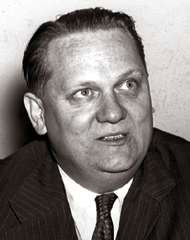William Dunn was with MacArthur when he landed in the Philippines in October 1944. His NY Times Obituary of Sept 21, 1992 tells his story:
WILLIAM J DUNN
William J. Dunn, CBS Radio Correspondent, 86
By Raymond Hernandez
Sept. 21, 1992
William J. Dunn, a CBS radio correspondent who covered Gen. Douglas MacArthur and the war in the Pacific from 1941 to 1945, died on Saturday at Northern Dutchess Hospital in Rhinebeck, N.Y. He was 86 years old and lived in Rhinebeck.
He died of heart failure after a lengthy illness, said Joe Wershba, a friend and former producer for "60 Minutes."
Mr. Dunn was with General MacArthur and American troops when they liberated the Philippine island of Leyte from the Japanese on Oct. 20, 1944.
In a photo of the liberation of Leyte, Mr. Dunn is seen alongside General MacArthur and five other men wading ashore in Leyte Gulf. Mr. Dunn is carrying a typewriter under his arm. That scene is also commemorated in a bronze statue that stands in Leyte Gulf.
Mr. Dunn wrote "Pacific Microphone," a book about the war in the Pacific, based on his diaries, notes and transcripts of his broadcasts from the field. The book was published in 1988 by Texas A & M University Press. Son of a Minister
Mr. Dunn was born in Rosedale, Ind., the son of a Methodist minister, and grew up in South Bend, Ind.
He began his career in journalism setting type at his brother's printing office at the age of 9. He joined The South Bend News Times in 1923 and later became a sports editor.
He also worked for news organizations including the United Press in Indianapolis, The Detroit News, the International News Service and The Associated Press. He was also the publicity director for American Airlines in its early years.
He joined the CBS news department in 1937 and began covering events in the Pacific a year before the Japanese attack on Pearl Harbor.

PRIVATE CITIZENS SUPPORTING AMERICA'S HERITAGE
American
War Memorials Overseas, Inc.
War Memorials Overseas, Inc.
Dunn William J
Name:
William J Dunn
Rank:
Civilian
Serial Number:
Unit:
South West Pacific Area (Command)
Date of Death:
1992-09-20
State:
Indiana
Cemetery:
Plot:
Row:
Grave:
Decoration:
Comments:
